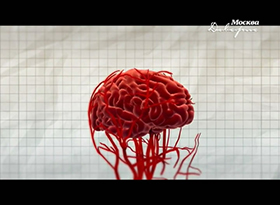ПУБЛИКАЦИИ
Cavernous Malformation of Brainstem, Thalamus, and Basal Ganglia: A Series of 176 Patients
- Создано 23.03.2013 11:47
Cavernous Malformation of Brainstem, Thalamus, and Basal Ganglia: A Series of 176 Patients
Pandey, Paritosh MD; Westbroek, Erick M. BS; Gooderham, Peter A. MD; Steinberg, Gary K. MD, PhD
BACKGROUND: Cavernous malformations (CMs) in deep locations account for 9% to 35% of brain malformations and are surgically challenging.
OBJECTIVE: To study the clinical features and outcomes following surgery for deep CMs and the complication of hypertrophic olivary degeneration (HOD).
METHODS: Clinical records, radiological findings, operative details, and complications of 176 patients with deep CMs were reviewed retrospectively.
RESULTS: Of 176 patients with 179 CMs, 136 CMs were in the brainstem, 27 in the basal ganglia, and 16 in the thalamus. Cranial nerve deficits (51.1%), hemiparesis (40.9%), numbness (34.7%), and cerebellar symptoms (38.6%) presented most commonly. Hemorrhage presented in 172 patients (70 single, 102 multiple). The annual retrospective hemorrhage rate was 5.1% (assuming CMs are congenital with uniform hemorrhage risk throughout life); the rebleed rate was 31.5%/patient per year. Surgical approach depended on the proximity of the CM to the pial or ependymal surface. Postoperatively, 121 patients (68.8%) had no new neurological deficits. Follow-up occurred in 170 patients. Delayed postoperative HOD developed in 9/134 (6.7%) patients with brainstem CMs. HOD occurred predominantly following surgery for pontine CMs (9/10 patients). Three patients with HOD had palatal myoclonus, nystagmus, and oscillopsia, whereas 1 patient each had limb tremor and hemiballismus. At follow-up, 105 patients (61.8%) improved, 44 (25.9%) were unchanged, and 19 (11.2%) worsened neurologically. Good preoperative modified Rankin Score (98.2% vs 54.5%, P = .001) and single hemorrhage (89% vs 77.3%, P < .05) were predictive of good long-term outcome.
CONCLUSION: Symptomatic deep CMs can be resected with acceptable morbidity and outcomes. Good preoperative modified Rankin Score and single hemorrhage are predictors of good long-term outcome.
- Удаление каверномы глубинных отделов правого полушария
- Клипирование de novo образованной аневризмы левой СМА
- Клипирование крупной частично тромбированной аневризмы
- Удаление каверномы в сочетании с амигдало-гиппокампэктомией
- Иссечение АВМ после частичной эмболизации композицией onyx
- Клипирование гигантской аневризмы СМА с применением методики ВАК





